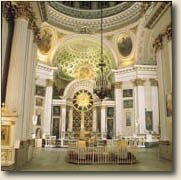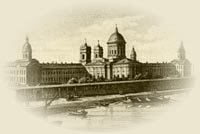The Architectural Ensemble.
 The Alexander Nevsky Lavra is a true artistic landmark of St Petersburg. Founded by Peter the Great's decree in 1710, the monastery became one of the first building sites in the Northern Russian capital, parallel with the Peter and Paul Fortress, the Admiralty and St Basil (Vasilyevsky) Island. The first wooden buildings of the monastery were erected on the left bank of the Black (Chornaya) River (now the Monastyrka river). The Alexander Nevsky Lavra is a true artistic landmark of St Petersburg. Founded by Peter the Great's decree in 1710, the monastery became one of the first building sites in the Northern Russian capital, parallel with the Peter and Paul Fortress, the Admiralty and St Basil (Vasilyevsky) Island. The first wooden buildings of the monastery were erected on the left bank of the Black (Chornaya) River (now the Monastyrka river).
The city's construction went hand in hand with the formation of the Russian architectural school. The ensemble of the Alexander Nevsky Lavra, being a result of fruitful collaboration of Russian and foreign architects, can be regarded as a wonderful example of merging and interaction of different architectural styles. Among those who took part in the designing and construction of its churches, towers and aisles were the outstanding architects Domenico Trezzini, Pietro Trezzini, Mikhail Rastorguyev, Piotr Yeropkin, Mikhail Zemtsov and Ivan Starov, the sculptor F. Shubin, the builders C.-F. Fossatti, A. Antonedo, A. Gornostayev, the decorators C. Fontano, F. Lamoni, I. Pinchetti, I. Akimov, the painters A. Antropov, J. Mettenleiter, F. Danilov, G. Ugryumov, and many other masters. The monastery was built during the eighteenth century.
 In his desire to surpass the greatest cities of Western Europe, Peter I began to invite architects and craftsmen from abroad. Among the first who came to St Petersburg was Domenico Trezzini who arrived from Switzerland. In 1716 Domenico Trezzini made a design of a monastery town that was taken as a basic one. In 1717 two-storied aisles of monastery cells in the eastern side were built. Galleries and aisles in the western, southern and northern sides had to be built too. In front of the courtyard a regular park was designed. In 1713 a long path was made across an impassable swamp to the center of the city which was to become in 1733 Neva Avenue (Nevsky Prospect). In 1724 the first stone church in Lavra, the Annunciation Cathedral (Blagoveshchensky Sobor) built by D. Trezzini in the style of early Russian Baroque, was consecrated, and soon the relic of St Prince Alexander Nevsky encased in a magnificent sarcophagus was brought to the monastery. In his desire to surpass the greatest cities of Western Europe, Peter I began to invite architects and craftsmen from abroad. Among the first who came to St Petersburg was Domenico Trezzini who arrived from Switzerland. In 1716 Domenico Trezzini made a design of a monastery town that was taken as a basic one. In 1717 two-storied aisles of monastery cells in the eastern side were built. Galleries and aisles in the western, southern and northern sides had to be built too. In front of the courtyard a regular park was designed. In 1713 a long path was made across an impassable swamp to the center of the city which was to become in 1733 Neva Avenue (Nevsky Prospect). In 1724 the first stone church in Lavra, the Annunciation Cathedral (Blagoveshchensky Sobor) built by D. Trezzini in the style of early Russian Baroque, was consecrated, and soon the relic of St Prince Alexander Nevsky encased in a magnificent sarcophagus was brought to the monastery.
Architect Theodore Shwertfeger designed a new cathedral and changed the configuration of the aisles of monastery cells so that the form of "circumferences" repeated the shape of the river bank. By 1750 the new cat-hedral had been nearly finished but in 1755 it was pulled down because of the technical errors in the design and very flimsy foundations. In 1740-1750 architect Pietro Trezzini built South-eastern aisle and the second corner church - Fyodorovskaya. In 1755 architect M. Rastorguyev designed the western aisle of monastery cells and "The Bishop's House" in Baroque style. At the same time the northern and southern aisles with open galleries and corner towers were built.
 In the second half of the eighteenth century the Baroque gave place to Classicism. The architecture of the buildings erected in this style is magestic, austere, expressive and, at the same time, simple and rational. The principal church, the St. Trinity Cathedral (Troitsky Sobor) built by Ivan Starov in 1790, can serve as a brilliant example of the style of Russian Early Classicism and of Russian applied art of the eighteenth century (the interior). Ivan Starov also worked on the main entrance to the monastery, the stone wall and the adjoining Alexander Nevsky Square which architecturally connected the monastery with the center of the city. He also united the aisles of monastery cells with the walls of the oldest cemeteries of St Petersburg. Peter the Great's beloved sister Natalia was buried in the monastery in the St. Lazarus Chapel built in 1717. This started St Petersburg's oldest cemetery where courtiers and high dignitaries were enterred. The famous Russian general of Peter's time B. Sheremetyev, the commander of the cavalry in the Patriotic war of 1812 F. Uvarov were buried there. Among the many outstanding personalities interred in the monastery cemetery were the great Russian scientist M. Lomonosov, the architects I. Starov, A. Voronikhin, G. Rossi, playwright D. Fonvizin. Many tombstones were designed by talented sculptors and architects such as I. Martos, M. Kozlovsky, A. Voronikhin, G. Quarenghi, F. Gordeev and others. In view of the great cultural and historic importance of the Alexander Nevsky Necropolis it was made a state preserve, and a Museum of Urban Sculpture was organized there in 1930. In the second half of the eighteenth century the Baroque gave place to Classicism. The architecture of the buildings erected in this style is magestic, austere, expressive and, at the same time, simple and rational. The principal church, the St. Trinity Cathedral (Troitsky Sobor) built by Ivan Starov in 1790, can serve as a brilliant example of the style of Russian Early Classicism and of Russian applied art of the eighteenth century (the interior). Ivan Starov also worked on the main entrance to the monastery, the stone wall and the adjoining Alexander Nevsky Square which architecturally connected the monastery with the center of the city. He also united the aisles of monastery cells with the walls of the oldest cemeteries of St Petersburg. Peter the Great's beloved sister Natalia was buried in the monastery in the St. Lazarus Chapel built in 1717. This started St Petersburg's oldest cemetery where courtiers and high dignitaries were enterred. The famous Russian general of Peter's time B. Sheremetyev, the commander of the cavalry in the Patriotic war of 1812 F. Uvarov were buried there. Among the many outstanding personalities interred in the monastery cemetery were the great Russian scientist M. Lomonosov, the architects I. Starov, A. Voronikhin, G. Rossi, playwright D. Fonvizin. Many tombstones were designed by talented sculptors and architects such as I. Martos, M. Kozlovsky, A. Voronikhin, G. Quarenghi, F. Gordeev and others. In view of the great cultural and historic importance of the Alexander Nevsky Necropolis it was made a state preserve, and a Museum of Urban Sculpture was organized there in 1930.
To the right of the Lavra entrance is the Tikhvinskoye Cemetery founded in 1823. During the nineteenth century there were buried many famous Russian writers and poets I. Krylov, N. Karamzin, V. Zhukovsky, F. Dostoyevsky; the composers M. Glinka, M. Mussorgsky, A. Borodin, P. Tchaikovsky, A. Dargomyzhsky, the artists I. Kramskoi, A. Kuinji, the art and musical critic I. Stasov, famous actors and actresses. In 1935 the cemetery was made into a necropolis of prominent art figures, and the remains of many outstanding people were brought there. The tombstones were designed also by Soviet sculptors M. Manizer, V. Ingal, M. Anikushin and others.
In 1960-1970 besides works on restoration the reconstruction of the district near the Lavra was carried out. Nowadays the ensemble of the Alexander Nevsky Lavra is one of the architectural, religious and historic centers of St Petersburg.
In the year 2003 Alexander Nevsky Square is to be decorated with a monument to St Prince Alexander Nevsky, the Holy Patron of Russia.
|

 Complete playbill of all St. Petersburg,Russia theatres, shows, concerts, etc. !
Complete playbill of all St. Petersburg,Russia theatres, shows, concerts, etc. !
 World-known music festival "The Stars of the White Nights".
World-known music festival "The Stars of the White Nights".




